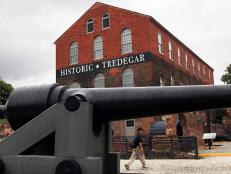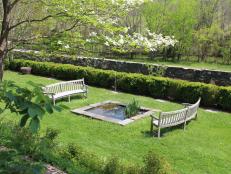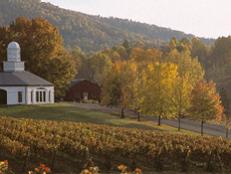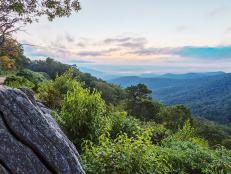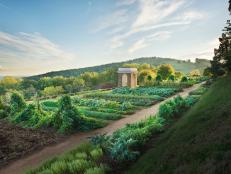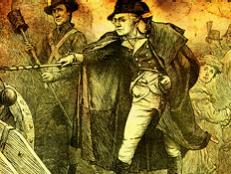A Presidential Tour of Virginia
Four out of America’s first five presidents were Virginians, and, though the Old Dominion hasn’t produced a chief executive since Staunton’s Woodrow Wilson, the state is still steeped in presidential history — from celebrated sites such as Mount Vernon and Monticello to Herbert Hoover’s ultra-private Camp Rapidan, hidden four miles’ hike into Shenandoah National Park.
Related To:
lessRelated To:
George Washington's Mount Vernon
It’s hard to picture the folk hero on the one-dollar bill as a living, breathing person — with a smokehouse full of country hams, a basement full of fortified wine and a back porch where he relaxed with friends. It’s easy, for those of us raised to worship the man as an icon of liberty and justice, to gloss over the fact that he also enslaved hundreds of people. This site brings it all to life, from the historic gardens planted with eighteenth-century crops to the reconstructed slave quarters to the general’s own feather bed.
James Madison's Montpelier
Madison, brainy and diminutive, is often overshadowed in the history books by his more dashing contemporaries — and his impressive home suffered a similar fate for more than a century, hidden under stucco and extensive renovations as the palatial country estate of the wealthy duPont family. After Marion duPont Scott willed the property to the National Trust for Historic Preservation in 1983, preservationists began the difficult task of restoring it to its original appearance. Today, the father of the Constitution is at home in Orange again, at a Montpelier dedicated to him and his beloved wife, Dolley.
Thomas Jefferson's Monticello
Jefferson’s mind was always on his country estate, where he carried out his architectural and agricultural experiments and accumulated his collections of books and artifacts from around the world — even when he was forced to attend to more pressing matters as president. On a sunny day, as you look out over miles of farmland and forest from the mountaintop, you can feel his optimism for a country built on the ideals of life, liberty and the pursuit of happiness. On a rainy day, when fog swallows the house, you can picture him hunched over his writing desk by candlelight, opining on the direction of the young nation.
Poplar Forest
Jefferson never allowed his architectural eccentricities as much free rein as he did at his lesser-known second home and plantation. Here, escaping from the public eye, the ever-curious and innovative statesman put geometry to work. The house is one large octagon, perhaps the first of its kind, with a perfect cube at its center surrounded by four octagonal rooms. The privies are octagons, too.
James Monroe's Ash Lawn-Highland
James Monroe moved to Albemarle County — within sight of Monticello — at the behest of Thomas Jefferson, and he named his estate Highland. Ash Lawn came later, bestowed by an owner who was impressed by the rows of mighty ash trees leading up the driveway — and likely would never have guessed that the name would take on another meaning when, in 2015, archeologists realized that Monroe’s actual house had burned down, probably sometime in the mid-1800s. The site’s curators, who had always known that at least part of the house was missing, have now concluded that the humble building they’d been interpreting as a wing of the original house was likely just a guest house. While they figure out what’s next, stop by to see what’s left of the plantation and stroll the beautiful grounds.
University of Virginia
Jefferson, Madison and Monroe were the first, second and third rectors of the two-hundred-year-old University of Virginia — first built, according to Jefferson’s plans, on Monroe’s farmland. Today, the nineteenth-century Rotunda and Academical Village, along with the nearby Monticello, make up a UNESCO World Heritage Site. Students can still apply to bunk in the fifty-four original brick rooms.
John Tyler's Sherwood Forest
John Tyler’s grandson still lives in his sprawling family home, a century and a half after his grandfather, our tenth president, died. It seems impossible, but the numbers add up, just barely — thanks to two generations that married twice and had children with younger women late in life. You can schedule a house tour with Harrison Tyler and his wife, Frances. (More trivia: This is the only house ever owned by two non-related presidents. William Henry Harrison — who died after thirty-one days in office, making Vice President Tyler the president — owned it first, before Tyler changed the name from Walnut Grove to Sherwood Forest to reflect his outlaw reputation.)
Berkeley Plantation
You’ve heard, of course, the story of the First Thanksgiving — when, on December 4, 1619, Captain John Woodlief and the thirty-five settlers who’d crossed the ocean on the Good Ship Margaret gave thanks to God on the shores of Virginia, at the present-day site of the Berkeley Plantation. No? Well, don’t bring up those pilgrims or their silly hats when you’re at one of the oldest and most prestigious plantations in Virginia. Benjamin Harrison III planted his flag on the property in 1691, establishing a home for generations of prominent Harrisons, including ninth president William Henry Harrison. The family lost the home after the Civil War. (Twenty-third president Benjamin Harrison grew up in Ohio.)
Woodrow Wilson Presidential Library & Museum
Joseph and Jessie Wilson left Staunton for Augusta, Georgia, in 1858, when little Thomas Woodrow Wilson, then called "Tommy," was just a year old. Staunton hasn’t forgotten its native son, though — thanks in part to Wilson’s widow, who urged the town to memorialize the World War I leader. Visitors can tour Wilson’s birthplace, restored to its 1856 appearance, and the Woodrow Wilson Museum.
Rapidan Camp
Before Camp David, there was Rapidan. President Herbert Hoover, needing an escape from D.C., spent his own money to build a rustic retreat at the headwaters of the Rapidan River, in what is now Shenandoah National Park, in 1929. Hoover and his wife, Lou, fly-fished and hiked on the remote property, sometimes with luminaries including Thomas Edison, Charles Lindbergh and British Prime Minister Ramsay MacDonald. Hoover’s wheelchair-bound successor, Franklin Roosevelt, visited Rapidan once before opting to vacation instead at Camp Shangri-La — which Dwight Eisenhower renamed Camp David — in Maryland. Rapidan fell into disrepair. Today, it’s accessible to national park day-trippers by a four-mile round-trip hike or a guided van tour. The three main buildings have been restored, and the trout fishing is still world-class.
